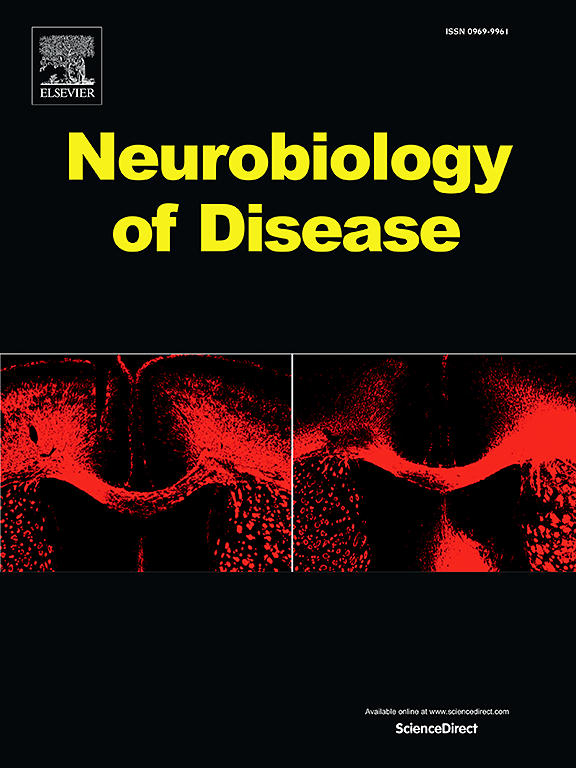儿童时期发作的锰诱导的肌张力障碍帕金森病小鼠模型的小脑功能障碍。
IF 5.6
2区 医学
Q1 NEUROSCIENCES
引用次数: 0
摘要
携带锰(Mn)转运体基因SLC39A14致病性变异的人表现出高脑锰浓度和儿童期发病的肌张力障碍-帕金森病。在这里,我们发现slc39a14敲除(KO)小鼠,一种CB中Mn浓度升高的疾病的临床前模型,表达了与小脑(CB)功能障碍相关的生理震颤缺陷。同步x射线荧光显微镜对浦肯野细胞(PCs)细胞内Mn的成像证实了Slc39a14-KO小鼠PCs中Mn浓度的高升高。为了确定Slc39a14-KO小鼠相对于野生型(WT)的CB中改变的生物学途径,我们进行了RNA测序,发现调节免疫反应和细胞死亡的途径和基因显著上调。为了证实这些发现,我们对Slc39a14-KO小鼠脑脊液中的神经炎症生物标志物易位蛋白18 kDa (TSPO)进行了定量放射自显像,TSPO与WT相比在脑脊液中显著增加。后者的发现通过小胶质细胞标志物Iba-1的免疫染色证实,显示了脑脊液皮层中广泛的小胶质细胞激活和聚集。细胞凋亡标志物cleaved caspase-3 (cCASP3)免疫染色显示,Slc39a14-KO小鼠中cCASP3免疫标记阳性的PCs数量相对于WT增加。苏木精和伊红(H&E)染色证实PCs变性。最后,脑脊液神经回路的功能电生理评估显示,小脑核(CN)神经元的放电速率明显降低,PCs简单尖峰放电的变异性增加。总的来说,这些发现首次表明,mn诱导SLC39A14 - ko小鼠的PCs变性和CB电路功能障碍,为SLC39A14突变携带者的肌张力障碍样运动、平衡和步态异常的病理基础提供了额外的证据。本文章由计算机程序翻译,如有差异,请以英文原文为准。
Cerebellar dysfunction in a mouse model of childhood-onset manganese-induced dystonia parkinsonism
Humans with pathogenic variants of the manganese (Mn) transporter gene SLC39A14 exhibit highly elevated brain Mn concentrations and childhood-onset dystonia-parkinsonism. Here we show that Slc39a14-knockout (KO) mice, a preclinical model of the disease with elevated Mn concentrations in the CB, express deficits in physiological tremor implicating cerebellar (CB) dysfunction. Imaging of intracellular Mn in Purkinje cells (PCs) using synchrotron-based X-ray fluorescence microscopy confirmed highly elevated Mn concentrations in the PCs of Slc39a14-KO mice. To determine biological pathways altered in the CB of Slc39a14-KO mice relative to wildtype (WT), we performed RNA sequencing and discovered significant upregulation of pathways and genes regulating immune response and cell death. To substantiate these findings, we performed quantitative autoradiography of the neuroinflammation biomarker Translocator Protein 18 kDa (TSPO) which was significantly increased in the CB of Slc39a14-KO mice relative to WT. The latter findings were confirmed via immunostaining with the microglial marker Iba-1, revealing widespread microglia activation and clustering in the CB cortex. Immunostaining for cleaved caspase-3 (cCASP3), a marker of apoptosis, showed increased number of PCs with positive immunolabeling for cCASP3 in Slc39a14-KO mice relative to WT. Degeneration of PCs was confirmed by Hematoxylin and Eosin (H&E) staining. Lastly, functional electrophysiological assessment of CB neurocircuitry revealed a marked decrease in firing rates of cerebellar nuclei (CN) neurons and increased variability of PC simple spikes firing. Collectively, these findings show, for the first time, Mn-induced PC degeneration and dysfunctional CB circuitry in Slc39a14-KO mice providing additional evidence for the pathological underpinnings of the dystonia-like movements, balance, and gait abnormalities in SLC39A14 mutation carriers.
求助全文
通过发布文献求助,成功后即可免费获取论文全文。
去求助
来源期刊

Neurobiology of Disease
医学-神经科学
CiteScore
11.20
自引率
3.30%
发文量
270
审稿时长
76 days
期刊介绍:
Neurobiology of Disease is a major international journal at the interface between basic and clinical neuroscience. The journal provides a forum for the publication of top quality research papers on: molecular and cellular definitions of disease mechanisms, the neural systems and underpinning behavioral disorders, the genetics of inherited neurological and psychiatric diseases, nervous system aging, and findings relevant to the development of new therapies.
 求助内容:
求助内容: 应助结果提醒方式:
应助结果提醒方式:


